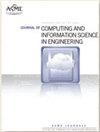制造业网络安全风险建模与评估的分类驱动图论框架
IF 2.6
3区 工程技术
Q2 COMPUTER SCIENCE, INTERDISCIPLINARY APPLICATIONS
Journal of Computing and Information Science in Engineering
Pub Date : 2023-10-10
DOI:10.1115/1.4063729
引用次数: 0
摘要
识别、分析和评估网络安全风险对于制定有效的决策策略以保护关键制造业免受潜在的网络攻击至关重要。然而,目前还缺乏一种针对制造业的定量方法来有效地模拟威胁事件并评估离散制造系统中独特的网络安全风险。作为回应,本文引入了第一个分类驱动的图论模型和框架,以正式表示这种独特的网络安全威胁景观,并识别需要优先控制的易受攻击的制造资产。首先,提出的框架使用制造特定威胁属性的分类分类来描述威胁行为者的技术、策略和程序,并将这些属性集成到网络安全风险建模中。这有助于系统地为离散制造系统生成全面和通用的网络物理攻击图。其次,使用攻击图形式化,所提出的框架可以对各种网络安全威胁进行并发建模和分析,包括不同的攻击向量、位置、漏洞和后果。风险模型捕获了通过制造系统中的不同网络和物理实体的不同攻击方法的级联攻击影响,从而导致特定的后果。然后,对构建的网络物理攻击图进行分析,以了解威胁在离散制造价值链中的传播,并识别潜在的攻击路径。第三,提出了一种定量风险评估方法来评估与潜在攻击路径相关的网络安全风险。它还能识别出成功可能性最大的攻击路径,指出需要优先控制的关键制造资产。最后,通过一个实例对所提出的风险建模与评估框架进行了论证。本文章由计算机程序翻译,如有差异,请以英文原文为准。
Taxonomy-Driven Graph-Theoretic Framework for Manufacturing Cybersecurity Risk Modeling and Assessment
Abstract Identifying, analyzing, and evaluating cybersecurity risks is essential to devise effective decision-making strategies to secure critical manufacturing against potential cyberattacks. However, a manufacturing-specific quantitative approach to effectively model threat events and evaluate the unique cybersecurity risks in discrete manufacturing systems is lacking. In response, this paper introduces the first taxonomy-driven graph-theoretic model and framework to formally represent this unique cybersecurity threat landscape and identify vulnerable manufacturing assets requiring prioritized control. First, the proposed framework characterizes threat actors' techniques, tactics, and procedures using taxonomical classifications of manufacturing-specific threat attributes and integrates these attributes into cybersecurity risk modeling. This facilitates systematic generation of comprehensive and generalizable cyber-physical attack graphs for discrete manufacturing systems. Second, using the attack graph formalism, the proposed framework enables concurrent modeling and analysis of a wide variety of cybersecurity threats comprising varying attack vectors, locations, vulnerabilities, and consequences. The risk model captures the cascading attack impact of varying attack methods through different cyber and physical entities in manufacturing systems, leading to specific consequences. Then, the constructed cyber-physical attack graphs are analyzed to comprehend threat propagation through the discrete manufacturing value chain and identify potential attack paths. Third, a quantitative risk assessment approach is presented to evaluate the cybersecurity risk associated with potential attack paths. It also identifies the attack path with the maximum likelihood of success, pointing out critical manufacturing assets requiring prioritized control. Finally, the proposed risk modeling and assessment framework is demonstrated using an illustrative example.
求助全文
通过发布文献求助,成功后即可免费获取论文全文。
去求助
来源期刊
CiteScore
6.30
自引率
12.90%
发文量
100
审稿时长
6 months
期刊介绍:
The ASME Journal of Computing and Information Science in Engineering (JCISE) publishes articles related to Algorithms, Computational Methods, Computing Infrastructure, Computer-Interpretable Representations, Human-Computer Interfaces, Information Science, and/or System Architectures that aim to improve some aspect of product and system lifecycle (e.g., design, manufacturing, operation, maintenance, disposal, recycling etc.). Applications considered in JCISE manuscripts should be relevant to the mechanical engineering discipline. Papers can be focused on fundamental research leading to new methods, or adaptation of existing methods for new applications.
Scope: Advanced Computing Infrastructure; Artificial Intelligence; Big Data and Analytics; Collaborative Design; Computer Aided Design; Computer Aided Engineering; Computer Aided Manufacturing; Computational Foundations for Additive Manufacturing; Computational Foundations for Engineering Optimization; Computational Geometry; Computational Metrology; Computational Synthesis; Conceptual Design; Cybermanufacturing; Cyber Physical Security for Factories; Cyber Physical System Design and Operation; Data-Driven Engineering Applications; Engineering Informatics; Geometric Reasoning; GPU Computing for Design and Manufacturing; Human Computer Interfaces/Interactions; Industrial Internet of Things; Knowledge Engineering; Information Management; Inverse Methods for Engineering Applications; Machine Learning for Engineering Applications; Manufacturing Planning; Manufacturing Automation; Model-based Systems Engineering; Multiphysics Modeling and Simulation; Multiscale Modeling and Simulation; Multidisciplinary Optimization; Physics-Based Simulations; Process Modeling for Engineering Applications; Qualification, Verification and Validation of Computational Models; Symbolic Computing for Engineering Applications; Tolerance Modeling; Topology and Shape Optimization; Virtual and Augmented Reality Environments; Virtual Prototyping

 求助内容:
求助内容: 应助结果提醒方式:
应助结果提醒方式:


